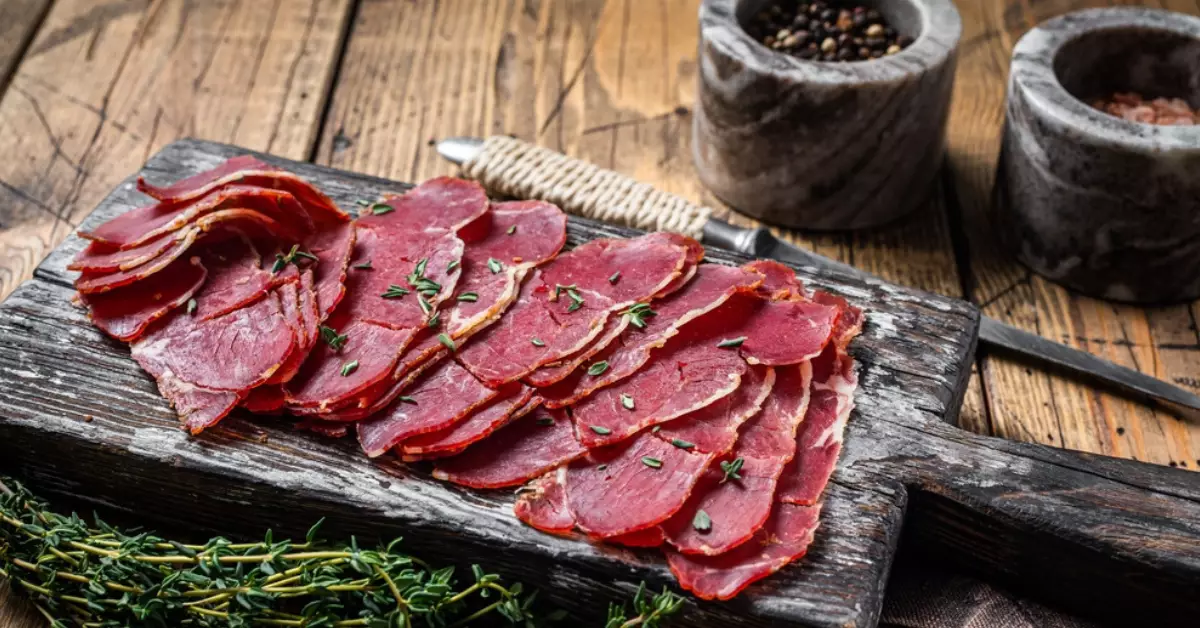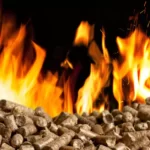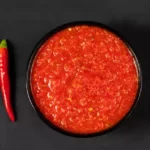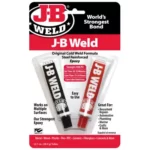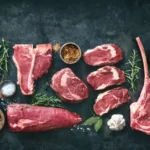Dried beef, a delightful food item that has been around for centuries, graces the tables of many cultures around the world. Known for its long shelf life and nutritional value, dried beef provides a handy and tasty snack option. Its unique preparation process, involving air drying or dehydrating beef, is a testament to human ingenuity in food preservation.
Essentially, dried beef is all about the art of removing moisture from the meat, thus preserving it for extended periods. This process intensifies the beef’s flavors, making it a versatile ingredient in numerous cuisines. You can munch on it as a protein-rich snack, add it to your soups for a depth of flavor, or even incorporate it into your breakfast meals.
The beauty of dried beef lies in its simplicity. It is a relatively straightforward process, although it requires patience and precision. In the world of meat preservation, making dried beef is an exciting endeavor with delicious outcomes.
Understanding the Drying Process
The drying process plays a central role in the creation of dried beef. By reducing the water content, you not only extend the meat’s shelf life but also increase its resistance to spoilage bacteria. The result is a safe, portable, and flavorful meat product.
Why is Drying Important for Beef?
Drying beef is more than just removing water content. The process enhances the beef’s flavors, creating a concentrated taste that is sought after in many recipes. Moreover, drying beef also reduces its weight and volume, making it more portable and easy to store.
The Role of Dehydration in Preserving Meat
Dehydration is crucial in preserving meat. It helps inhibit the growth of spoilage organisms, thus preventing the meat from going bad. Furthermore, the lack of moisture creates an inhospitable environment for bacteria, extending the shelf life of the beef considerably.
Preparation Essentials for Dried Beef
The process of making dried beef requires meticulous planning and execution. From selecting the right cut of beef to gathering necessary ingredients and equipment, everything plays a pivotal role.
Choosing the Right Cut of Beef
Opt for lean cuts when choosing beef for drying. These cuts have less fat, which could otherwise go rancid during the drying process. Examples of suitable cuts include eye round roast, top round roast, or bottom round roast.
Ingredients Required for Drying Beef
A simple marinade can elevate the flavors of your dried beef. Traditional ingredients include salt, sugar, and various spices. These not only flavor the meat but also aid in the preservation process.
Necessary Equipment for Drying Beef
A dehydrator or an oven with low temperature settings is the primary equipment needed. You also need a sharp knife for slicing the meat, a mixing bowl for the marinade, and airtight containers for storage.
Step-by-Step Guide to Making Dried Beef
Making dried beef involves careful preparation, seasoning, drying, and storing. Here’s a detailed guide that covers every step in the process.
Initial Preparation: Cleaning and Slicing the Beef
The initial preparation involves cleaning and slicing the beef. Here’s how to go about it:
- Clean the Beef: Start by thoroughly washing the beef under cold running water. This helps remove any surface bacteria, ensuring a safe and clean start to the process.
- Trim the Fat: Next, trim all visible fat from your chosen cut of beef. Fat can go rancid during the drying process and affect the final taste and quality of your dried beef.
- Freeze the Beef: Partially freeze the meat for about 1-2 hours. This makes it easier to slice and allows for more uniform pieces.
- Slice the Beef: With a sharp knife, cut the beef into thin, uniform slices. Ideally, they should be around 1/4 inch thick. Slice against the grain for a more tender result. Uniform slicing not only ensures even drying but also impacts the texture and taste of your dried beef.
Seasoning: How to Marinate the Beef
The seasoning step involves marinating the beef to infuse it with flavors. Here’s a simple process:
- Prepare the Marinade: Mix your chosen marinade ingredients in a bowl. A basic marinade might include salt, black pepper, and sugar. Feel free to experiment with other spices like smoked paprika, garlic powder, onion powder, or cayenne pepper for additional flavor.
- Marinate the Beef: Coat the beef slices evenly with the marinade, ensuring each slice is well-covered. This will help the flavors penetrate the meat.
- Refrigerate: Place the marinated beef slices in a covered dish or a zip-top bag. Let the beef sit in the marinade for several hours or overnight in the refrigerator. The longer it marinates, the stronger the flavors will be.
Drying Process: Techniques for Dehydrating the Beef
The drying process is where the magic happens. Follow these steps for best results:
- Arrange the Beef: Arrange the marinated beef slices on the dehydrator trays. Make sure they don’t overlap or touch each other. This allows for good air circulation and ensures even drying.
- Set the Temperature: Set your dehydrator or oven to a low temperature, around 140°F (60°C). High temperatures might cook the beef instead of drying it.
- Dry the Beef: Dehydrate the beef slices until they are dry and leathery. The exact time can vary from 4 to 12 hours, depending on the thickness of the slices, the type of dehydrator or oven used, and the desired dryness.
- Check the Beef: It’s important to check the beef regularly during the drying process. The beef should be flexible and leathery, not brittle. It should also have a uniform color. If the beef turns dark or black, it might be over-dried.
Storing: Tips for Keeping Your Dried Beef Fresh
Proper storage is crucial for maintaining the quality and shelf life of your dried beef. Here’s what to do:
- Cool Down: Allow the dried beef slices to cool at room temperature before packing. This prevents condensation, which could lead to mold growth.
- Pack the Beef: Pack the cooled, dried beef slices into airtight containers or vacuum-sealed bags. This prevents moisture and air from reaching the beef, prolonging its shelf life.
- Store Properly: Store the packed dried beef in a cool, dark, and dry place. The pantry or a kitchen cupboard is typically a good choice. If properly stored, your homemade dried beef can last several months.
Safety Precautions while Making Dried Beef
Making dried beef at home is quite safe, as long as you follow some key precautions.
Importance of Meat Handling Hygiene
It’s crucial to maintain high hygiene standards when handling meat to prevent foodborne illnesses. Always wash your hands thoroughly before and after working with raw meat. Likewise, clean all surfaces and equipment that come in contact with raw meat.
Safe Temperature Ranges for Drying Beef
When drying beef, it’s important to maintain a safe temperature. This should be around 140°F (60°C). Temperatures below this range might not kill bacteria effectively, posing a risk to your health.
Exploring Variations of Dried Beef
Dried beef is incredibly versatile. There are countless variations you can try, and numerous ways to use dried beef in cooking.
Popular Dried Beef Recipes around the World
Dried beef is a global favorite. Here are a few popular variations from different parts of the world:
- Biltong: This South African snack is made by curing and drying beef or other types of meat. Biltong is often spiced with coriander, black pepper, and vinegar for a distinctive flavor.
- Bresaola: An Italian delicacy, bresaola is made from air-dried, salted beef that has been aged for several months. The result is a dark red, almost purple, dried beef with a sweet and musty smell.
- Cecina: This Spanish dried beef is salted, smoked, and air-dried, often served thinly sliced like carpaccio.
Creative Ways to Use Dried Beef in Cooking
Dried beef can be a delicious addition to various dishes. Here are a few ideas:
- Salads: Chop up some dried beef and toss it into your favorite salad for a boost of protein and flavor.
- Sandwiches: Layer some dried beef in your sandwiches for a hearty lunch.
- Pasta: Dried beef can add a savory, meaty flavor to pasta dishes.
- Snacks: Simply enjoy dried beef as is for a protein-rich snack.
- Flavoring: You can even grind dried beef into a powder and use it as a flavor booster in soups, stews, and sauces.
Common Mistakes to Avoid when Making Dried Beef
Even with the best intentions, mistakes can happen when making dried beef. Here are a few common ones to avoid:
Over-Drying or Under-Drying: Finding the Right Balance
Getting the right level of dryness can be tricky. Over-dried beef can be too tough and brittle, while under-dried beef might spoil quickly. It’s important to regularly check the beef during the drying process. The beef should be dry but still flexible.
Incorrect Slicing: The Impact on Texture and Taste
How you slice the beef can greatly impact the final product. Cutting with the grain can make the dried beef tougher, while cutting against the grain results in a more tender texture. Also, aim for thin, uniform slices for even drying and optimal texture.
The Health Benefits of Dried Beef
Dried beef is not only delicious, but it’s also quite nutritious.
Nutritional Content in Dried Beef
Dried beef is an excellent source of protein, which is vital for muscle repair and growth. It also contains various vitamins and minerals, including iron, zinc, and B vitamins. Just be aware that dried beef can be high in sodium due to the salt used in the drying process.
Incorporating Dried Beef into a Balanced Diet
Dried beef can certainly fit into a balanced diet. Its high protein content can help keep you feeling full and satisfied. Just remember to watch your portion sizes due to the high sodium content. Pair dried beef with lots of veggies for a nutritious, balanced meal.
Frequently Asked Questions
What is the best way to store dried beef?
The best way to store dried beef is in an airtight container or vacuum-sealed bag in a cool, dark, and dry place. Proper storage can extend the shelf life of your dried beef to several months.
Can I make dried beef without a dehydrator?
Yes, it’s possible to make dried beef without a dehydrator. You can use an oven set to a low temperature (around 140°F or 60°C). It may take longer than a dehydrator, but the results can be just as good.
How long does homemade dried beef last?
If stored properly, homemade dried beef can last several months. Always check for signs of spoilage, such as mold or a foul smell, before consuming.
Conclusion
Making dried beef at home is a rewarding process. It requires some patience and attention to detail, but the result is a tasty, nutritious snack that can be enjoyed in many ways. Whether you’re a beginner or an experienced cook, drying beef is an adventure worth embarking on. Enjoy the process, learn from your mistakes, and discover the joy of creating this ancient, beloved food.

